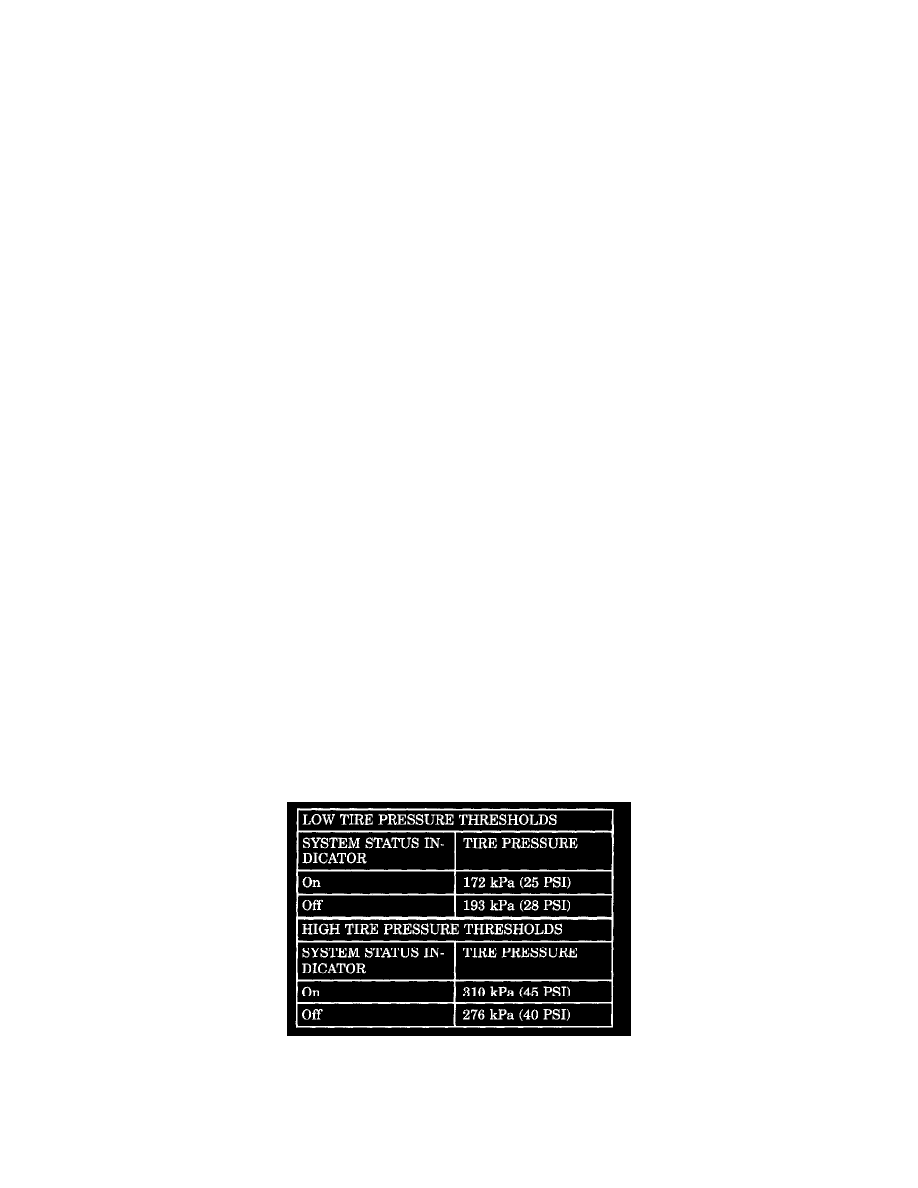Grand Cherokee 2WD V8-4.7L VIN J (2004)

Tire Pressure Monitoring System
If equipped with the Tire Pressure Monitoring System, each of the vehicle's five wheels will have a valve stem with a pressure sensor and radio
transmitter built in. Signals from the tire pressure sensors are received and interpreted by the Electronic Vehicle Information Center (EVIC).
A sensor in a mounted wheel will broadcast its detected pressure once per minute when the vehicle is moving faster than 40 km/h (25 mph). The spare
tire sensor will broadcast once every hour. Each sensor's broadcast is uniquely coded so that the EVIC can determine location. The individual tire
pressures can be displayed graphically on the EVIC.
NOTE: The spare tire is only monitored when equipped with the 5-Tire TPM System.
TRAINING THE EVIC
The EVIC can be trained to recognize the source locations of pressure sensor signals. The training procedure is given below:
1. Locate "RETRAIN TIRE SENSORS" on the EVIC menu. When this mode is enabled by selecting "YES", the EVIC will initiate the following
procedure.
2. A display will prompt the user to: "TRAIN LEFT FRONT TIRE". At this point the user must set the left front tire sensor to learn mode by
positioning a magnet (Relearn Magnet special tool 8821) over the valve stem for at least 5 seconds. The Remote Tire Pressure Monitor
(RTPM) in the front left tire will transmit a message indicating to the EVIC that it is in learn mode. When the EVIC has received this message
and is assured that it has learned an ID, the EVIC will request a horn chirp via a bus message and then display the next train request. NOTE:
There is a 60 second timer for learning the first tire location and a 30 second timer between the remaining tires. If any of these timers expire
the EVIC will abort the training procedure.
3. The EVIC will request the initiation of a training sequence for each tire, one-by-one in a clockwise direction around the vehicle (Left Front,
Right Front, Right Rear, Left Rear and Spare). The EVIC will allow 30 seconds (60 seconds for the first tire) from the beginning of the train
request display to the receipt of a unique learn ID message from the RTPM. If, during a training session, a 60 or 30 second timer expires
before a unique learn sensor ID is received or the vehicle is not in park, the EVIC will keep the previous set of trained IDs and will display
"TRAINING ABORTED" until a button is pressed. Any IDs learned during the current session will be discarded. The EVIC will not store one
ID for multiple locations.
NOTE: The spare tire is only monitored when equipped with the 5-Tire TPM System.
4. Once all four (or five) tires are successfully trained, the previous set of stored IDs will be replaced by the new IDs, and the EVIC will display,
"TRAINING COMPLETE" until a button is pressed.
If the vehicle is equipped with the Homelink feature and a Homelink button is pressed at any time during the training procedure, the EVIC module will
immediately exit the training procedure, discard any IDs learned in the current session and perform the Homelink function. After the button is
released, the module will display "RETRAIN TIRE SENSORS? NO".
The training procedure can be stopped at any time by pressing the C/T, STEP, RESET or MENU button. When any of these buttons are pressed the
EVIC will display "TRAINING ABORTED."
Once training is complete, the EVIC can determine when the spare wheel has been mounted on the vehicle. The spare wheel sensor/transmitter is
expected to transmit once per hour. If the sensor/ transmitter ID for the spare wheel is received at a shorter interval, the EVIC will request a chime and
display "SPARE SWAP DETECTED" for five seconds.
NOTE: The spare tire message is only available when equipped with the 5-Tire TPM System.
PRESSURE THRESHOLDS
The EVIC will monitor the tire pressure signals from the four (or five) tire sensors and determine if any tire has gone below the low pressure threshold
or raised above the high pressure threshold. Refer to the table.
CRITICAL AND NON-CRITICAL PRESSURE ALERTS
